Dear Mike,
Finally getting back to you on our electric problem from last fall. We took it into our local mechanic and he found the problem to be a Fusible Link. All tests out OK right now.
We were able to get the codes from a Ford dealer on the way home. That was after our dash lights went out for a minute or two. The Ford dealer didn’t normally see motorhomes but after many other places couldn’t see us for months, they were able to get us in at lunch hour.
But what exactly is a fusible link? - Peggy B.
Hey Peggy,
Glad this worked out for you. And this is a great opportunity to discuss exactly what a fusible link is. It can be a point of confusion when troubleshooting an electrical system that’s dead. But in reality a fusible link is just a really big fuse.
Inside a conventional fuse
Basically, a fuse is just a short section of wire that’s much smaller in diameter and can carry less current than the load conductors.
Here’s what one looks like that’s good, as well as what it looks like after it’s blown. You can see that the U-Shaped wire inside of the good fuse on the left is continuous. But in the blown fuse on the right there’s a little section of the wire that’s melted. And that’s what prevents any more current from flowing, which is what protects the other wires from melting. Essentially, it’s a sacrificial element which is designed to melt before any other damage can occur.
Some have lights…
And some of these fuses have a built-in miniature LED bulb which lights up when the fuse is blown, and the device it’s powering is turned on. So when the light is off, the fuse is good. But when the light is on, the fuse is blown. It’s a bit counterintuitive, but that’s how it works.
This is really handy, since you can often find a blown fuse just by looking for a light in the panel of other fuses. More on that later…
What is a fusible link?
A fusible link is just a large amperage fuse with a replaceable element, or a short length of special wire designed to melt at a certain amperage. These can have current ratings of hundreds of amperes.
And typically, a fusible link bolts onto a busbar on the battery terminal or inline with the wiring. And when it “blows” from too much current flow, a fusible element opens up internally just like a conventional fuse.
How to test one…
Since a fusible link is really just a big fuse, you test it like you test any other fuse. You can use a digital or analog multimeter with an ohms or continuity function to test a fuse or fusible link that’s out of the circuit. A good fuse will cause the meter to beep on the continuity setting, but not beep with a blown fuse. It’s really that simple.
Here’s a typical manual range meter
Set your meter for ohms of resistance or continuity
On the lower left of the dial you’ll see settings for 200 ohms, 2000 ohms, 20k ohms (which is 20,000 ohms), 200k ohms, and 2000k ohms (which is 2 million ohms). The only one we’ll worry about for basic RV continuity testing is the 200-ohm setting. Ignore the rest for now.
Let the testing begin…
Here’s how to test any fuse for being open (blown) or continuity (good). All good fuses should measure very close to a dead short resistance (around 1 ohm or less). All blown fuses should measure very close to infinity (many millions of ohms), which will show up on this particular meter with an OL reading on the face for Over-Limit.
Set the meter to the Diode/Continuity setting and place the test leads on both sides of the fuse which has been removed from the circuit. NEVER test a fuse in the circuit using the ohms or continuity setting if power is applied since you can blow the meter.
I’m showing a little cartridge fuse in the picture, but this works for any fuse. And because the resistance you’re looking for is so low, you can touch the fuse contacts with your fingers and it won’t affect your readings, nor can it shock you. If the beeper sounds, and the reading on the meter face is around 1 ohm, then all is well with the fuse. Note that this same setting works for 1-amp, 10-amp, 100-amp or even 1,000-amp fuses. The 10-amp setting on the meter has nothing to do with resistance testing of fuses.
Let’s use the resistance (ohms) setting
You can also use the 200-ohm setting on the meter if you like, or if your own meter doesn’t have a continuity/beep setting.
In this case the same basic rules apply. If the meter reads less than 1 ohm or so, then the fuse has continuity and is good. But if the meter reads OL, for Over-Limit, then the fuse has infinite resistance and is blown. Again, never test a fuse using the resistance or continuity settings while the fuse is in the circuit, especially if power is applied. You’ll either get confusing meter readings, or you might just blow up your meter.
Digital voltmeters are great tools, but only if you understand how to use them. And always be extra careful when measuring 120- or 240-volt circuits. Yes, that voltage is really going into your meter, and if you make a mistake like putting the test leads on the energized circuit first, and then turn the selector knob to the desired setting, you’ll probably spin though the milli-amp or resistance settings on the way there. A good meter will just blow the fuse, but a cheap meter may just die. So don’t go there.
Much more later…
Once again, don’t try to test a fuse or fusible link with the ohms or continuity settings while it’s in-circuit with power applied. That’s another article! 🧐
Let’s play safe out there… Mike

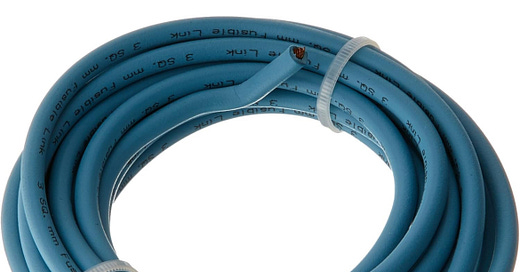



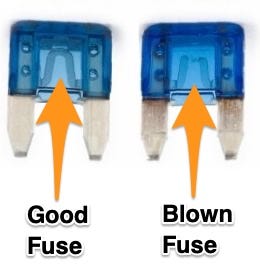
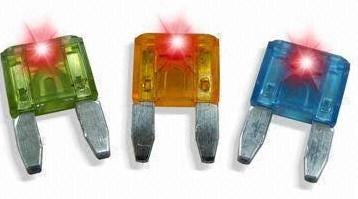
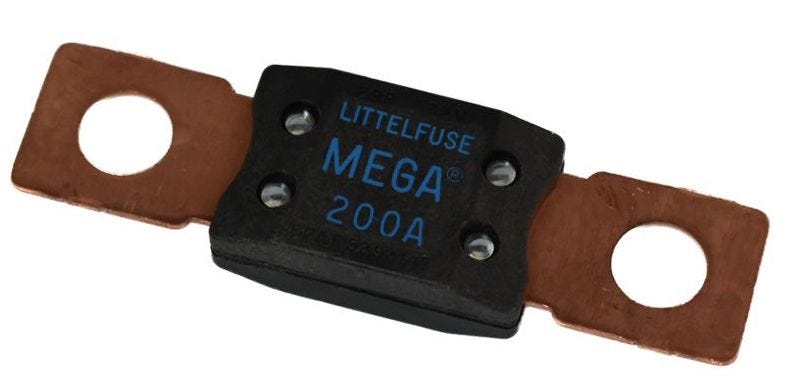
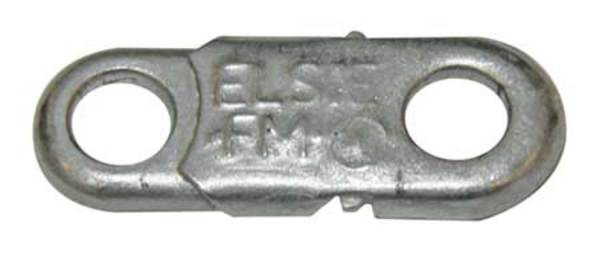



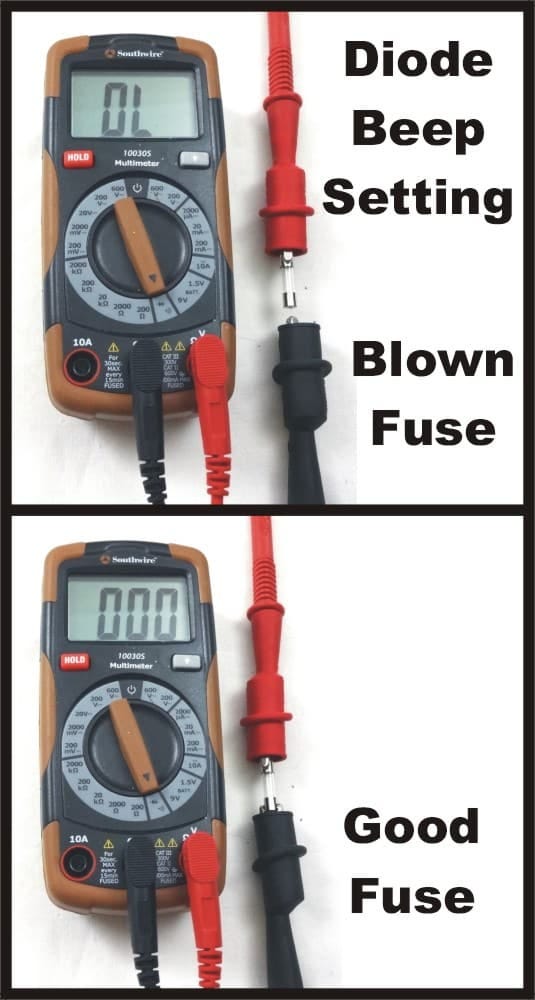

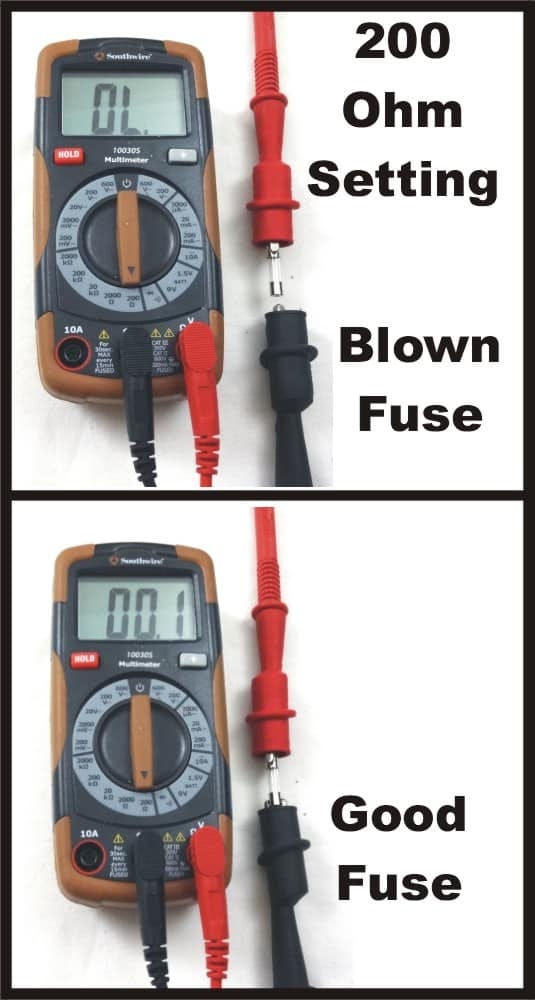

A little more info on Fusible Link wires, if I may. The purpose of a Fusible Link is to introduce a calibrated weak point in the wire run which like a fuse will burn out before compromising the full wire, and the short length will not produce voltage drop. Fusible Links are more dependable than cartridge fuses since they are not affected by heat, moisture, dirt, mud, grease, etc. and can last as long as the original wire harness. Fusible Links should not be used in the interior of a vehicle, because a burning Fusible Link will produce sparks and smoke.
Fusible Links have been used in OEM wiring on many vehicles for over fifty years and are extremely dependable as well as being inexpensive. A Fusible Link wire is generally four wire gauge numbers smaller than the wire being protected, eg. 18 AWG (American Wire Gauge) Fusible Link for a 14 AWG wire, 16 AWG for a 12 AWG wire, 14 AWG for a 10 AWG wire, 12 AWG for an 8 AWG wire. The gauge may be printed on the wire or on the connector, and may also be indicated by metric size, eg. 0.8 SQ mm = 18 AWG, 1.0 SQ mm = 16 AWG, 2.0 SQ mm = 14 AWG, 3.0 SQ mm = 12 AWG. They are usually about six inches long +/- ½ inch and have a crimped and soldered ring connector on one end with an insulated connector on the other end to connect to the larger wire.
Fusible Link wire can be purchased at most auto parts stores.